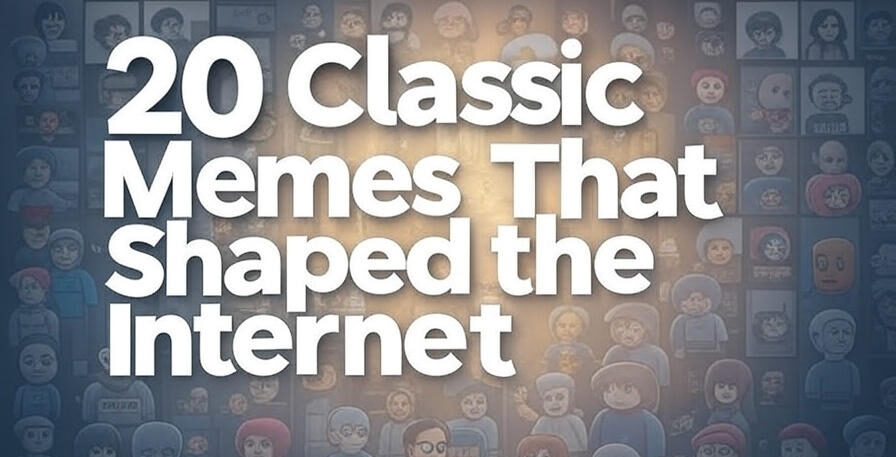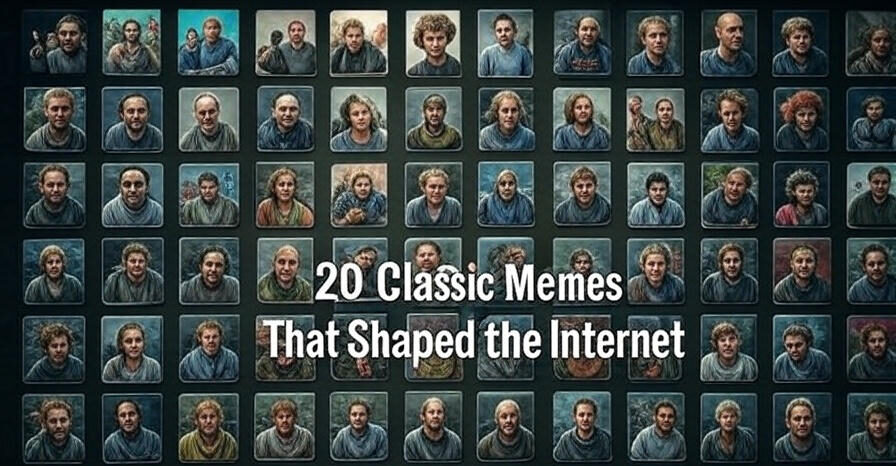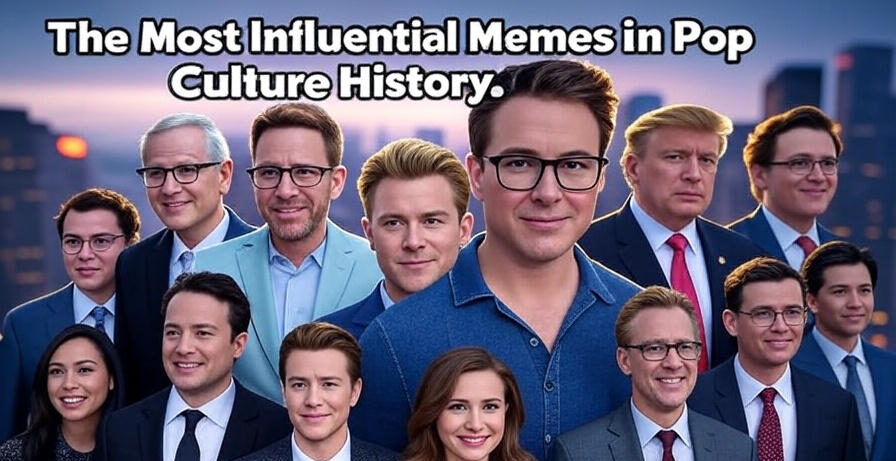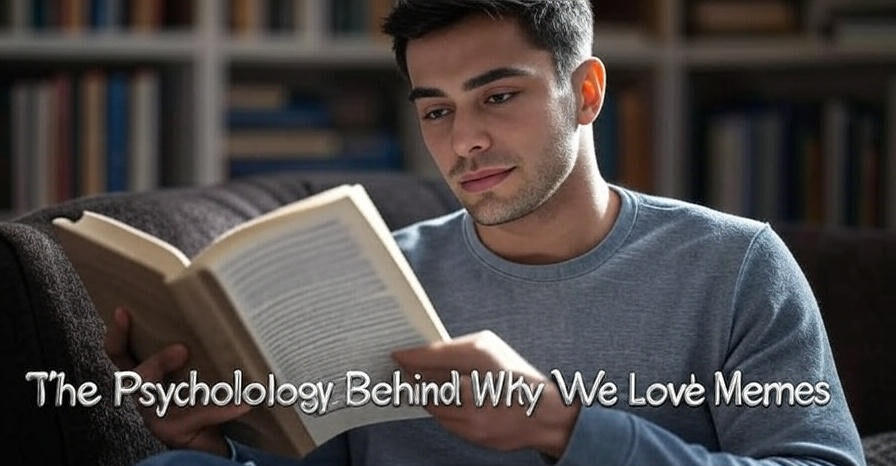 I still remember the first time I saw a “Rickroll” happening in real-time. It was 2008, and my friend had just sent me what he claimed was a “leaked trailer” for a movie I was dying to see. Instead, Rick Astley’s smooth voice filled my computer speakers with “Never Gonna Give You Up.” I was annoyed, confused, and somehow impressed all at once. Little did I know, I had just experienced one of the internet’s most legendary pranks.
I still remember the first time I saw a “Rickroll” happening in real-time. It was 2008, and my friend had just sent me what he claimed was a “leaked trailer” for a movie I was dying to see. Instead, Rick Astley’s smooth voice filled my computer speakers with “Never Gonna Give You Up.” I was annoyed, confused, and somehow impressed all at once. Little did I know, I had just experienced one of the internet’s most legendary pranks.
That moment sparked my fascination with internet memes – those viral pieces of content that somehow capture our collective digital consciousness. Over the past 15 years, I’ve watched memes evolve from simple image macros to complex cultural phenomena that influence everything from marketing campaigns to political movements.
What Makes a Meme “Classic”?
Before we dive into our list, let’s talk about what separates classic memes from the countless viral moments that fade into obscurity. In my experience studying digital culture, classic memes share several key characteristics:
- Longevity: They remain relevant years after their initial popularity
- Cultural Impact: They influenced internet behavior or spawned countless variations
- Widespread Recognition: Even non-internet natives recognize them
- Memetic Evolution: They adapted and transformed across different platforms
The Evolution of Internet Humor
Early Internet Era (1990s-2005)
The earliest memes were simple, text-based jokes shared in forums and email chains. I remember forwarding those chain emails with “funny” ASCII art to my entire contact list (sorry, everyone). These laid the groundwork for what was coming.
The Image Macro Revolution (2005-2012)
This period saw the birth of what most people think of as “traditional” memes – images with text overlaid in Impact font. Sites like 4chan, Reddit, and early social media platforms became breeding grounds for viral content.
Modern Meme Culture (2012-Present)
Today’s memes are faster, more complex, and often require insider knowledge to understand. They spread across platforms instantly and evolve at lightning speed.
20 Classic Memes That Changed Everything
1. Dancing Baby (1996)
Origin: Created by Michael Girard for a 3D animation software demo Peak Popularity: 1996-1998 Cultural Impact: Featured on Ally McBeal TV show
I have to start with the Dancing Baby because it was truly the first viral internet phenomenon I witnessed. This low-poly 3D baby doing a cha-cha dance was shared via email and early websites. What made it special was how it jumped from digital culture into mainstream media when Ally McBeal featured it as a recurring character.
The Dancing Baby proved that internet content could influence traditional media, setting a precedent that continues today.
2. Hamster Dance (1998)
Origin: Created by Canadian art student Deidre LaCarte Peak Popularity: 1998-1999 Cultural Impact: One of the first websites to achieve massive viral status
The Hamster Dance was pure, innocent internet joy. Rows of animated hamsters dancing to a sped-up sample of “Whistle Stop” from Disney’s Robin Hood. I spent way too many hours watching these tiny rodents boogie, and apparently, so did millions of others.
This meme demonstrated the internet’s power to make absolutely anything go viral, no matter how random or silly.
3. All Your Base Are Belong To Us (2001)
Origin: Mistranslation from the 1989 video game Zero Wing Peak Popularity: 2001-2002 Cultural Impact: Popularized “Engrish” humor and remix culture
“All your base are belong to us” became the internet’s first major broken English meme. The poor translation from Japanese to English in Zero Wing’s opening cutscene spawned thousands of remixes, parodies, and references.
I loved how this meme showcased the internet’s ability to find humor in the most unexpected places and transform it into something universally recognized.
4. Badger Badger Badger (2003)
Origin: Created by Jonti Picking (Weebl) Peak Popularity: 2003-2004 Cultural Impact: Demonstrated the addictive nature of looped content
“Badger badger badger badger badger badger badger badger MUSHROOM MUSHROOM!” If you know, you know. This hypnotic flash animation featuring badgers and the occasional snake was impossible to stop watching.
Weebl’s creation taught us that repetition and catchy music could create genuinely addictive internet content – a lesson that platforms like TikTok have perfected today.
5. Numa Numa (2004)
Origin: Gary Brolsma lip-syncing to “Dragostea Din Tei” by O-Zone Peak Popularity: 2004-2005 Cultural Impact: Pioneered webcam performance videos
Gary Brolsma’s enthusiastic lip-sync performance to the Romanian pop song “Dragostea Din Tei” was pure internet gold. His genuine joy and uninhibited dancing made everyone smile, even if they’d never heard the song before.
This video established the template for countless webcam performances and reaction videos that dominate social media today.
6. Chocolate Rain (2007)
Origin: Tay Zonday’s original song and video Peak Popularity: 2007-2008 Cultural Impact: Launched the career of a YouTube star
Tay Zonday’s deep voice delivering social commentary over a simple piano melody became an instant classic. “Chocolate Rain” tackled serious topics like racism and inequality while maintaining an oddly catchy, meme-worthy quality.
This showed how memes could carry meaningful messages while still being entertaining – something we see constantly in today’s political meme culture.
7. Rickroll (2007)
Origin: Posting Rick Astley’s “Never Gonna Give You Up” as bait-and-switch Peak Popularity: 2007-2009 (ongoing) Cultural Impact: The most successful internet prank of all time
I mentioned my first Rickroll experience earlier, and it perfectly captures why this meme became legendary. The prank was simple: trick someone into clicking a link that led to Rick Astley’s 1987 hit instead of the promised content.
What made Rickrolling brilliant was its harmless nature – nobody got hurt, and Rick Astley’s song is actually pretty catchy. Even Rick himself embraced the meme, performing it live at various events.
8. LOLcats (2007)
Origin: 4chan’s /b/ board and later I Can Has Cheezburger? Peak Popularity: 2007-2010 Cultural Impact: Established the template for animal memes
“I can has cheezburger?” became the battle cry of early internet culture. LOLcats combined adorable cat photos with broken English captions, creating an entirely new form of digital communication.
These memes taught us that animals + silly text = internet gold, a formula that’s still used in everything from Doge to modern pet TikToks.
9. David After Dentist (2009)
Origin: David DeVore’s post-anesthesia video filmed by his father Peak Popularity: 2009-2010 Cultural Impact: Popularized viral family moments
“Is this real life?” Young David’s existential crisis after dental surgery resonated with millions of viewers. His genuine confusion and philosophical questioning while high on anesthesia was both hilarious and oddly profound.
This video showed how authentic, unscripted moments could become viral sensations, paving the way for today’s spontaneous social media content.
10. Double Rainbow (2010)
Origin: Paul “Bear” Vasquez’s emotional reaction to a double rainbow Peak Popularity: 2010-2011 Cultural Impact: Celebrated genuine human emotion online
Paul Vasquez’s overwhelmed reaction to seeing a double rainbow (“Oh my God! It’s a double rainbow!”) captured the internet’s heart. His pure joy and wonder reminded us that sometimes the simplest things can be absolutely magical.
This meme proved that authentic emotion could be just as viral as manufactured content.
The Golden Age of Image Macros (2010-2012)
11. Pepe the Frog (2008-Present)
Origin: Matt Furie’s “Boy’s Club” comic Peak Popularity: 2010-2016 Cultural Impact: Became a symbol of internet culture (later controversially adopted by extremist groups)
Originally, Pepe was just a chill frog saying “feels good man.” I watched this innocent character evolve into thousands of variations expressing every possible emotion. Unfortunately, Pepe was later co-opted by hate groups, showing how memes can be weaponized.
Despite the controversy, Pepe remains significant for demonstrating how a simple character can become a universal language for expressing feelings online.
12. Grumpy Cat (2012)
Origin: Photo of Tardar Sauce, a cat with permanent frowning expression Peak Popularity: 2012-2019 Cultural Impact: Became the face of internet pessimism and generated millions in revenue
Grumpy Cat’s perpetually annoyed expression perfectly captured how many of us feel about daily life. The cat’s owner turned this viral fame into books, merchandise, and even a movie deal.
This meme proved that the right viral content could become a legitimate business empire.
13. Distracted Boyfriend (2015)
Origin: Stock photo by Antonio Guillem titled “Disloyal man walking with his girlfriend and looking amazed at another seductive girl” Peak Popularity: 2017-2018 Cultural Impact: Became the ultimate template for showing conflicted choices
Though the photo was taken in 2015, it exploded in 2017 when people started using it to represent everything from career changes to food choices. The boyfriend looking back at another woman while his girlfriend looks disapproving became the perfect metaphor for temptation and difficult decisions.
I’ve seen this format used for everything from serious political commentary to deciding between pizza toppings.
The Social Media Revolution
14. Harlem Shake (2013)
Origin: Baauer’s electronic song combined with dance videos Peak Popularity: February 2013 Cultural Impact: Demonstrated the power of viral challenges
The Harlem Shake phenomenon lasted only about a month, but what a month it was! The format was simple: 30 seconds of one person dancing alone, then everyone going crazy when the beat dropped.
I watched schools, offices, and even military units create their own versions. It showed how quickly a simple format could spread across different communities and demographics.
15. Doge (2013)
Origin: Photo of Kabosu, a Shiba Inu dog, combined with broken English phrases Peak Popularity: 2013-2014 (ongoing in crypto culture) Cultural Impact: Influenced internet language and eventually became a cryptocurrency
“Much wow. Such meme. Very doge.” The combination of Kabosu’s expressive face with broken English delivered in Comic Sans font created something uniquely absurd and lovable.
Doge’s influence extended far beyond memes when Dogecoin became a real cryptocurrency, proving that internet jokes could have serious financial implications.
16. Salt Bae (2017)
Origin: Turkish chef Nusret Gökçe’s dramatic salt-sprinkling technique Peak Popularity: 2017-2018 Cultural Impact: Transformed a chef into a global celebrity brand
Nusret’s theatrical way of sprinkling salt on meat, complete with sunglasses and a flourish, captured the internet’s imagination. The simple gesture became a symbol of confidence and style.
I watched this meme transform a local chef into an international celebrity with restaurants worldwide, showing how viral fame could create real-world business success.
Modern Meme Classics
17. This Is Fine (2013)
Origin: Webcomic by KC Green featuring a dog sitting in a burning room Peak Popularity: 2016-Present Cultural Impact: Became the symbol of willful ignorance in crisis situations
“This is fine” perfectly captured the feeling of maintaining composure while everything falls apart around you. The dog calmly drinking coffee in a burning room became the ultimate representation of denial and forced optimism.
This meme gained particular relevance during major news events, giving people a way to express their feelings about overwhelming situations.
18. Expanding Brain (2017)
Origin: Four-panel image showing increasingly glowing brains Peak Popularity: 2017-2018 Cultural Impact: Created a format for showing escalating levels of intelligence or absurdity
The Expanding Brain format allowed people to show progression from normal thinking to increasingly “enlightened” (often absurd) perspectives. Each panel showed a brighter, more elaborate brain image.
I loved how this template could work for both genuine educational content and completely ridiculous comparisons.
19. Woman Yelling at Cat (2019)
Origin: Combination of Taylor Armstrong from Real Housewives and Smudge the Cat Peak Popularity: 2019-2020 Cultural Impact: Became a versatile reaction format
This meme combined a screenshot of Taylor Armstrong crying and pointing from Real Housewives with a photo of a confused-looking white cat sitting at a dinner table. The contrast between human drama and feline indifference was comedy gold.
The format became perfect for showing any kind of one-sided argument or misunderstanding.
20. Among Us (2020)
Origin: Characters from the video game Among Us Peak Popularity: 2020-2021 Cultural Impact: Created a new vocabulary around suspicion and deception
While Among Us was released in 2018, it exploded during the 2020 pandemic. The game’s characters and terminology (“sus,” “imposter”) entered everyday language, and the simple bean-shaped characters became instantly recognizable meme material.
Playing Among Us with friends during lockdown created countless inside jokes and memorable moments that extended far beyond the game itself.
The Science Behind Viral Memes
What Makes Content Shareable?
After years of observing meme culture, I’ve noticed several patterns that make content go viral:
| Factor | Description | Example |
|---|---|---|
| Relatability | Content that reflects common experiences | “This is Fine” dog |
| Humor | Makes people laugh or smile | LOLcats |
| Emotional Impact | Triggers strong feelings | Double Rainbow |
| Simplicity | Easy to understand and reproduce | Distracted Boyfriend |
| Timing | Releases at the right cultural moment | Among Us during pandemic |
The Psychology of Sharing
From my observations, people share memes for several psychological reasons:
- Social Connection: Sharing something funny creates bonds with friends
- Identity Expression: Memes let us show our personality and interests
- Cultural Participation: Being part of a shared cultural moment feels good
- Communication Tool: Sometimes a meme says what words cannot
How Memes Influence Society
Language Evolution
Memes have fundamentally changed how we communicate online. Phrases like “sus,” “it’s giving,” and “no cap” started as meme language before entering mainstream vocabulary.
I’ve watched my own language evolve to include meme references in everyday conversation. When something goes wrong, I might say “this is fine” with the same energy as the burning dog.
Marketing and Advertising
Companies quickly realized that meme culture could sell products. Brands started creating their own memes or jumping on trending formats to connect with younger audiences.
However, I’ve noticed that forced corporate memes often fall flat. The best brand memes feel authentic and understand the original context rather than simply copying the format.
Political Discourse
Memes have become powerful tools for political communication. Complex policy positions can be reduced to shareable images that spread faster than traditional news articles.
While this democratizes political participation, it also raises concerns about oversimplification of important issues.
The Future of Meme Culture
Platform Evolution
As social media platforms evolve, so do memes. TikTok’s short-video format has created entirely new types of viral content, while platforms like Discord enable more niche, community-specific memes.
Artificial Intelligence Impact
AI-generated content is starting to influence meme creation. While this opens new creative possibilities, it also raises questions about authenticity and human creativity in digital culture.
Global Connectivity
The internet’s global reach means memes can now cross cultural and language barriers more easily than ever. I’ve seen American memes adapted for different cultural contexts and vice versa.
Lessons from Meme Culture
The Democratization of Fame
Memes have shown that anyone can become internet famous overnight. You don’t need professional equipment or industry connections – just the right content at the right time.
The Power of Community
The best memes emerge from communities rather than being manufactured by corporations. Authentic engagement and genuine cultural moments still resonate more than produced content.
Temporary vs. Lasting Impact
While most viral content fades quickly, truly classic memes endure because they capture something fundamental about human experience or digital culture.
Creating Your Own Viral Content
Understanding Your Audience
Based on my observations, successful meme creators understand their audience deeply. They know what resonates, what timing works, and how to adapt existing formats creatively.
Tips for Aspiring Meme Creators
- Stay Current: Follow trending topics and formats
- Be Authentic: Forced content rarely works
- Understand Context: Know the history and proper usage of meme formats
- Time It Right: Posting at optimal times increases visibility
- Engage with Community: Participate in the culture you want to influence
The Dark Side of Meme Culture
Misinformation Spread
Memes can spread false information as quickly as entertainment. The visual format makes content seem more credible than it might actually be.
Harassment and Bullying
Sometimes memes can be used to target individuals, turning viral fame into a nightmare. The “Star Wars Kid” incident was an early example of how meme culture could harm real people.
Cultural Appropriation
Memes often originate in specific communities before being adopted mainstream, sometimes losing their original context or meaning in the process.
Preserving Internet History
Digital Archaeology
Organizations like the Internet Archive work to preserve viral content for future study. These digital archaeologists ensure that important cultural moments aren’t lost to broken links or deleted accounts.
Academic Interest
Universities now offer courses on internet culture and meme studies. What started as silly internet jokes has become legitimate academic research material.
Conclusion: The Lasting Legacy of Classic Memes
Looking back at these 20 classic memes, I’m struck by how they’ve shaped not just internet culture, but culture overall. They’ve changed how we communicate, how we express emotions, and how we connect with others across digital spaces.
These memes represent more than just entertainment – they’re a record of our collective digital experience. They capture moments of joy, frustration, confusion, and connection that define what it means to be human in the internet age.
From the Dancing Baby’s innocent charm to Among Us’s pandemic-era popularity, each meme tells a story about who we were as a culture when it emerged. They’re time capsules of digital evolution, showing how our online communities have grown and changed.
As we move forward into an increasingly connected world, new memes will continue to emerge, evolve, and eventually join the ranks of these classics. The formats may change, the platforms may shift, but the fundamental human need to share, laugh, and connect through viral content will remain.
The memes on this list didn’t just shape the internet – they shaped us. They taught us new ways to communicate, gave us shared reference points across different communities, and proved that humor truly is a universal language.
Whether you’re a longtime internet veteran who remembers dancing hamsters or a digital native who grew up with Among Us, these classic memes are part of our shared cultural DNA. They remind us that sometimes the most profound cultural moments can emerge from the most unexpected places – and that’s exactly what makes internet culture so endlessly fascinating.
The next time you see a classic meme, take a moment to appreciate its place in digital history. Behind every viral image or video is a community of people who found something worth sharing, and that’s a beautiful thing indeed.
For more insights into digital culture and internet phenomena, check out Know Your Meme for comprehensive meme documentation, or explore the Internet Archive to see how websites and viral content have evolved over time.




